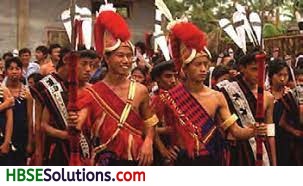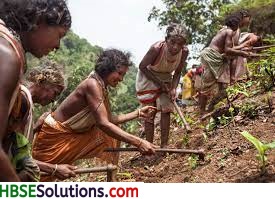Haryana State Board HBSE 8th Class Social Science Solutions Civics Chapter 7 Understanding Marginalisation Textbook Exercise Questions and Answers.
Haryana Board 8th Class Social Science Solutions Civics Chapter 7 Understanding Marginalisation
HBSE 8th Class Civics Understanding Marginalisation Textbook Questions and Answers
Understanding Marginalisation Class 8 Questions And Answers HBSE Question 1.
Write in your own words two or more sentences of what you, understand by the word ‘marginalisation’.
Answer:
‘Marginalisation’ is a social process by which certain sections of the society are confined to lower social standing. It results, to certain minority (such as Muslims) or Dalits (particularly among the Hindus) in having a low social status and not having equal access to education and other resources.
Understanding Marginalisation Class 8 HBSE Question 2.
List two reasons why Adivasis are becoming increasingly marginalised.
Answer:
Adivasis are becoming increasingly marginalised because:
(i) They are radically different from communities organised around the principle of jati-vama (castes).
(ii) Their way of life is quite different from the majority of people. They wear colourful costumes, strange type of head gears and have different cultures. They like to live in seclusion.
Class 8 Civics Chapter 7 HBSE Question 3.
Write one reason why you think the constitution’s safeguards to protect minority communities is very important.
Answer:
The Constitution safeguards to protect minority communities to protect India’s cultural diversity and promote equality as well as justice.
![]()
Class 8 Civics Chapter 7 Question Answer HBSE Question 4.
Reread the section on Minorities and Marginalisation. What do you understand by the term minority?
Answer:
The term minority is most commonly used to refer to communities that are numerically small in relation to the rest of the population.
Class 8th Civics Chapter 7 HBSE Question 5.
You are participating in a debate where you have to provide reasons to support the following statement: ‘Muslims are a marginalised community’ using the data provided in this chapter list two reasons that you would give.
Answer:
Muslims are marginalised community because:
(i) They do not have equal access to basic amenities such as pucca house, electricity, piped water, etc.
(ii) Muslims have lowest literacy rates as compared to other religious groups of India.
Class 8 Understanding Marginalisation HBSE Question 6.
Imagine that you are watching the Republic Day parade on TV with a friend and she remarks, “Look at these tribals. They look so exotic. And they seem to be dancing all the time.”
List three things that you would tell her about the lives of Adivasis in India.
Answer:
(i) Adivasis led excluded life in different hilly and forests areas of India till the middle of the nineteenth century or the dawn of British imperialism in India.
(ii) Adivasis are not a homogeneous population. There are over 500 different Adivasi groups ‘n our country. They are particularly numerous, in states like Chhattisgarh, Jharkhand, Madhya Pradesh, Orissa, Gujarat, Maharashtra, Rajasthan, and in the north¬eastern states of Andhra Pradesh, Assam, Manipur, Meghalaya, Mizoram, Nagaland and Tripura.
(iii) Adivasis practise ancestor worship and believes in all types of supernatural spirits like the primitive men.
Class 8 Civics Chapter 7 Solutions HBSE Question 7.
In the story board, you read about how Helen hope to make a movie on the Adivasi story. Can you help her by developing a short story on Adivasis?
Answer:
The story runs like this:
A foreign company has planned to establish a metal company in area of Adivasis. They are forced to move in very large number to various areas of India. A man and his girl friend decide to make an association. They approach to district authority, state Govt, and lastly to central government.
Under their leadership, the Adiyasis demand three things forest, water and livelihood. After a long struggle, Human Right Commission comes forward and their demands are accepted. They are handed over fairly large forest-lands, supply of water and they are given employment in companies and some newly started small scale industries etc.
![]()
Class 8 Chapter 7 Civics HBSE Question 8.
Would you agree with the statement that economic and social marginalisation are interlinked? Why?
Answer:
The different reports about the marginalisation point out that economic and social marginalisation are interlinked.
(i) In terms of occupation, houses, piped water, Muslims lag behind many other religious groups.
(ii) Most of the Muslims work in unorganised sector and have lower living standards than Hindus as a whole. Because of lack of education, they find it difficult to get both public as well as private sector jobs.
(iii) Since they are economically backward, they fail to attain a higher status in Indian society. Thus, economic and social marginalisation are interdependent.
HBSE 8th Class Civics Understanding Marginalisation Important Questions and Answers
Very Short Answer Type Questions
Class 8 Civics Understanding Marginalisation HBSE Question 1.
Who are Adivasis?
Answer:
Adivasis literally means ‘original inhabitants’ who lived and often continue to live, in close association with forests.
Chapter 7 Civics Class 8 HBSE Question 2.
How much percent of India’s population is Adivasi?
Answer:
Around 8 percent.
Civics Chapter 7 Class 8 HBSE Question 3.
Name the important mining ana industrial centres where Adivasis are located.
Answer:
Jamshedpur, Rourkela, Bokaro and Bhilai.
Understanding Marginalisation Question Answer HBSE Question 4.
About how many Adivasi groups are there in India?
Answer:
About 500 different Adivasi groups are there in India.
Short Answer Type Questions
Class 8 Civics Chapter 7 Understanding Marginalisation Question Answer HBSE Question 1.
How have Adivasis been treated by the state and private industrialists for the past 200 years.
Answer:
Adivasis have been increasingly forced through economic chagnes, forest policies and political force applied by the state and private industry. They migrated to live as worker in plantations, as construction sites, in industries and households.
Understanding Marginalisation Class 8 Notes Questions And Answers HBSE Question 2.
Why are safeguards required for minorities?
Answer:
(i) To protect minority communities against the possibility of being culturally dominated by the majority.
(ii) To protect minorities against any discrimination and disadvantage that they may face.
![]()
Long Answer Type Questions
Question 1.
How have the forests been important for life and development of Adivasis?
Answer:
Forests have been very important for life and development of Adivasis.
(i) Metal ores like iron and copper, gold and silver, coal and diamonds, invaluable timber, most medicinal herbs and animal products and animal themselves all come from forests.
(ii) The continuation of life depended heavily on forests, that help recharge many of India’s rivers.
(iii) Forests covered the major part of our country till the nineteenth century.
Question 2.
By whom were the following demands being made on forest land?
(a) Timber for construction of houses and railways.
(b) Forest land for mining.
(c) Reserved by government and wild life parks.
In what ways would this effect tribal people?
Answer:
(a) Timber for construction of houses demanded by companies enaged in construction, work Or by individual rich people or by joint groups or companies. Timber for railways is demanded by Central Government or by Railway Contractors.
(b) By mining companies, by industrialists or industrial companies.
(c) Ministry of Forest and Environment on behalf of government.
Question 3.
In what ways would this affect tribal people?
Answer:
These would affect life of tribal people in following ways:
(i) Tribal people will loose their land and forests.
(ii) Their lives will be disturbed as the continuation of life depends heavily on forests, that help recharge many of our country’s rivers.
(iii) The tribal people will face shortage in the availability and quality of air and water.
(iv) More than 50 percent of tribal persons have been displaced.
Picture-Based Questions
(A) Look at the pictures and answer the following questions.


Question 1.
What do the two pictures reflect?
Answer:
The two pictures reflect the traditional dresses and life-style of Adivasis.
Question 2.
What image do we get about Adivasis from the pictures?
Answer:
We come to know that Adivasis were ‘exotic’ and ‘backward’.
(B) Look at the adjoining picture of Niyamgiri Hill and answer the following questions:

Question 1.
Where is Niyamgiri Hill located?
Answer:
Niyamgiri Hill is located in Kalahandi district of Orissa.
Question 2.
Name the Adivasi community which inhabits this area.
Answer:
Dongarria Konds.
Question 3.
Why is Adivasi Community endangered to be displaced from here?
Answer:
Adivasi Community is endangered to be displaced from here because a major aluminium company is planing to set-up a mine and a refinery here.
Question 4.
What action has been taken by Adivasi Community against it?
Answer:
Adivasi people have strongly resisted this proposed development and have been joined by environmentalists as well. A case against the company is also pending in Supreme Court.
Understanding Marginalisation Class 8 HBSE Notes
- Hierarchy: A graded system or arrangement of persons or things. Usually persons at the bottom of the hierarchy are those who have the least power.
- Ghettoisation: A ghetto is an area or locality that is populated largely by members of a particular community. Ghettoisation refers to the process that leads to such a situation.
- Mainstream: Literally this refers to the main current of a river or stream. In this chapter it is used to refer to a cultural context in which the customs and practices that are followed are those of the dominant community. Mainstream is also used to refer to those people or communities that are considered to be at the centre of a society.
- Displaced: This, here, refers to people who are forced or compelled to move from their homes for big development projects including dams, mining etc.
- Militarised: An area where the presence of the armed forces is considerable.
- Malnourished: A person who does not get adequate nutrition or food.
- Adivasis: The term adivasis, literally means ‘original in habitants’.
- Socially Marginalised: To be forced to occupy the sides or fringes and thus not be at the centre of things or set-up.
- Santhali: A language mainly spoken by Santhal adivasis.
- Republic Day: It is the day (26th January) when the constitution of our country was adopted.
- Scheduled Castes: Those dalits or damits who have been officially enlisted for special reservation and facilities so that their development may take place quickly in the society and grouped as scheduled caste.
- Sachar Committee: The government set-up a high-level committee in 2005, that was chaired by justice Rajinder Sachar to examine status of the Muslims.
- Tribals: Tribals are also referred as Adivasis.